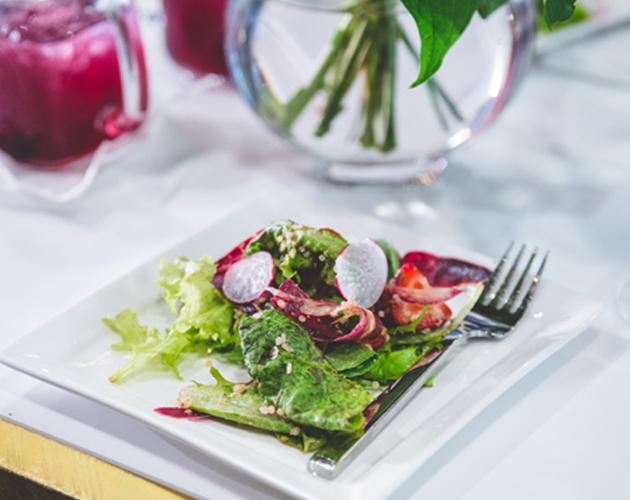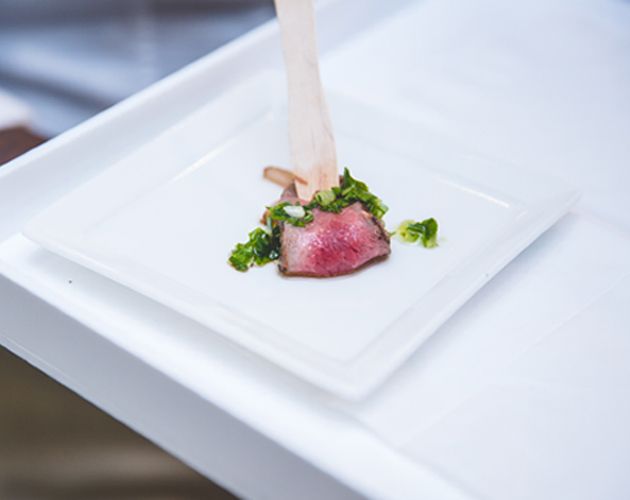Tips and Recipes for Better Eye Health

Here, we’re talking eye health and aging with Vancouver-based optometrist Dr. Pavan Avinashi.
Our eyes, like our skin, lose elasticity as we age affecting our ability to focus at close objects and that fine print. The condition is called presbyopia, the Latin translation of which is aging eye, notes Dr. Avinashi. “It starts pretty much in your 40s and it’s a gradual, consistent process that affects every human being,” he confirms.
So, what can we do? It turns out Avinashi recommendations start with what we shouldn’t do. That is to pick up a pair of generic readers in the drugstore aisle.
“They’re basically a magnifying glass. And using something that may be the incorrect strength can actually stress and fatigue the eye further,” he says.
See an eye doctor when you note vision changes
In addition to ensuring the correct strength, a prescription can correct for conditions such as astigmatism – irregular curvature of the cornea affecting as much as 40 per cent of the population.
Wear sunglasses, year-round
Also similar to our skin, sun exposure results in oxidative damage to the eye. Although he says that 50 per cent of the damage is down by the time we’re 20, Avinashi’s advice includes donning shades year-round. Look for lenses that block 100 per cent of UV rays and also absorb most HEV rays – both of which reach us whether it’s sunny or not.
Combat screen strain
We spend an average of 8 hours and 41 minutes per day in front of an electronic device and that can cause asthenopia, or eyestrain characterized by blurred vision, sporadic double vision, premature tiredness, and the inability to maintain a consistently clear image at a distance. Avinashi says to follow the 20-20-20 rule: every 20 minutes, look away for 20 seconds and focus on something 20 feet away.
Blink more
Blinking helps regulate tear film and flow, which helps keep our eyes naturally moist. But we blink up to 50 per cent less often when focused on a screen, which can contribute to dry eyes. As can certain medications as well as hormone changes, most often in women as they age. Make a point to stop and actively blink through the day Avinashi advices, and stay well hydrated . (Dietitians of Canada recommends 2.2 litres (9 cups) of fluids each day for women and 3 litres (12 cups) for men.)
Contact comfort
Avinashi says multifocal contact lens technology has come a long way since coming to market about 15 years ago. “Not everybody, but I’d say 95 per cent of people can get on with multifocal contact lens.”. Contact lenses inherently disrupt the eye’s natural lubrication and as we age our oil glands and our tear glands don’t function to the same degree. He recommends Alcon Dailies Total1 Multifocal contact lenses as their patented technology releases moisture molecules into the eyes as you blink. Bye, bye bifocals!
Avinashi also recommends seeing your eye doctor regularly. Not only to keep your prescription up-to-date but also to screen for conditions such as age-related macular degeneration – the leading cause of vision loss among older adults.
Research has also shown that a healthy diet including carotenoid compounds such as beta-carotene, lutein and zeaxanthin, and vitamins C and E. zinc and omega-3 fatty acids are important for eye health. Here, recipes for eye health courtesy of Chef Brad Long, owner of Toronto’s Café Belong. Long incidentally notes that an added advantage of multifocal contacts is that the lenses help keep him from crying when cutting onions. Bonus!
Carrot & Apple Soup by Brad Long
Ingredients:
1 lb. (500g) or so of fresh carrots, roughly chopped
1/2 lb. (250g) tart apples, peeled, seeded, and roughly chopped
1 medium onion, roughly chopped
3 tbsp. (45mL) sweet butter
5 cups (1.2L) chicken or vegetable stock (or water)
1 tbsp. (15mL) or so of cider vinegar
½ cup (125mL) 35% cream (optional)
Salt to taste
Directions:
Melt the butter in a medium pot (4L) and add the onions and sweat – NOT Sauté – them on low heat for at least 15 minutes so they begin to melt into clear, sweet, love. Add in the carrots at the same heat and continue to slowly cook, stirring occasionally, perhaps nudging the heat up a bit so they are breaking down but not browning. “When the carrots have started to round at the edges add the apples and most of the stock and bring to a boil.
By the time the carrots are cooked through, the apples should be melted into the rest but sometimes they hold up – this isn’t a concern as long as the carrots have cooked through.
Purée this mixture in a blender (not all at once – at least in two batches) and return to a clean pot. Bring this mixture to a gentle boil being careful to slowly stir so it doesn’t burn on the bottom. You can add more stock if it’s too thick, you can add the cream, and you may need both as there is a distinct variable in the carrots and apples in that they may need far more or far less liquid depending on varietal, age,and too many things to make this easy to be specific. Their starchiness is the only tricky variable so you may need to add more liquid and you can decide how thick you wish your soup to be.
Add the cider vinegar and add salt a bit at a time until it is perfectly seasoned to
Divide into cups or bowls and garnish with a few small basil leaves, chives, parsley, or something growing in your garden.
Makes 4 servings.
NEXT: St. Lawrence Salad by Brad Long

St. Lawrence Salad by Brad Long
Browned Butter Vinaigrette Ingredients:
8 tbsp. (125mL) salted butter (1/4 lb/125g)
1 tsp. (5mL) minced shallot
3 tbsp. (45mL) cider vinegar
3/4 tsp. (4mL) honey
1/4 tsp. (1mL) dijon mustard
Kosher salt to taste
Salad Ingredients:
2 carrots (or other fresh roots such as parsnips or beets)
About 6 oz. (170g) mixed salad greens and micro greens (about 12 cups/3L loosely packed)
About 1/4 cup (60mL) cold cooked grains (such as quinoa, pearl/pot barley, spelt)
About 1/2 cup (125mL) raw pecans or other nuts, toasted
1 pear or other tree fruit (such as apple or peach), thinly sliced with skin on
About 1/4 cup (60mL) dried cranberries (or other dried fruit such as raisins or cherries)
About 2 oz (60g) crumbled chèvre (soft, unripened goat’s cheese) or other young cheese
Fresh flat-leaf parsley leaves
For vinaigrette, in medium saucepan, melt butter over high and watch closely as it foams, falls and foams again while the solids start to brown and smell like toasted hazelnuts. This may take 3 to 5 minutes depending on your stove. Remove from heat as soon as the butter browns so it doesn’t burn.
Place shallots in medium stainless steel bowl. Place fine-mesh strainer over bowl. Slowly pour butter through strainer, being careful as it will foam; discard solids (little browned bits). Let cool 5 minutes. Whisk in vinegar, honey and mustard. Taste; adjust if desired. Whisk again. You should have about 1/2 cup (125mL).
This vinaigrette must be served warm. If not using immediately, transfer to plastic squeeze bottle and refrigerate up to 2 weeks. When ready to use, place squeeze bottle in bowl of hot water until it warms and loosens again. Or place in saucepan of briskly simmering water. Shake well before using.
For salad, peel and trim carrot or other roots. Using vegetable peeler, shave into long, extremely thin strips. Transfer to bowl of ice water until curled and crisp, about 10 minutes. When ready to use, drain and pat dry.
In large mixing bowl, combine roots, greens, nuts, fruit, cheese and parsley. Add 1/4 cup (60mL) vinaigrette. Toss well; taste. Add more vinaigrette, 1 tbsp. (15mL) at a time, if desired.
Mound on serving platter. Serve immediately.
Makes 4 servings.
Next: Salsa Verde by Brad Long

Salsa Verde by Brad Long
Ingredients
3/4 cup (177mL) of extra virgin olive oil
1 small peeled shallot or clove of garlic
1 bunch of Italian parsley
1 bunch of herbs of your choice
Pinch of salt
1 tbsp. (15mL) cider vinegar
Directions:
Mix together the extra virgin olive oil, peeled shallot, Italian parsley and herbs of your choice into a blender. Blend until it is a textured paste. Add more oil if not mixing well.
Season to taste with salt and cider vinegar. Serve with steak plate.
Makes one cup for serving.